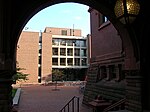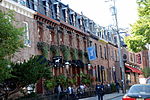Penn Institute for Urban Research
2004 establishments in PennsylvaniaResearch institutes established in 2004Research institutes in PennsylvaniaSustainable urban planningUniversity of Pennsylvania ... and 2 more
Urban economicsUrbanization
The Penn Institute for Urban Research (Penn IUR) is an interdisciplinary research center at the University of Pennsylvania. The Institute is affiliated with the 12 schools at the University of Pennsylvania, and housed at the University of Pennsylvania School of Design.The Institute was founded in 2004, and focuses on three main research areas: 1) Exploring innovative urban development strategies; 2) Building the inclusive 21st century sustainable city; and 3) Understanding the role of anchor institutions in urban places.Eugenie L. Birch and Susan M. Wachter are the Co-Directors of Penn IUR.
Excerpt from the Wikipedia article Penn Institute for Urban Research (License: CC BY-SA 3.0, Authors).Penn Institute for Urban Research
South 34th Street, Philadelphia
Geographical coordinates (GPS) Address Nearby Places Show on map
Geographical coordinates (GPS)
| Latitude | Longitude |
|---|---|
| N 39.952185 ° | E -75.192817 ° |
Address
Meyerson Hall (School of Design)
South 34th Street 210
19104 Philadelphia
Pennsylvania, United States
Open on Google Maps








